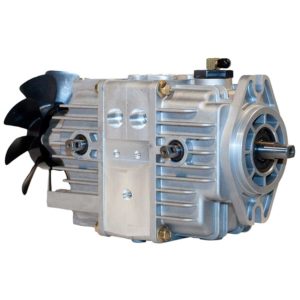Using mechanical energy produced by a machine’s engine, a hydraulic pump can move hydraulic fluid from the pump’s own reservoir to a connected hydraulic motor, converting the mechanical energy to hydraulic energy. The incoming fluid/energy triggers the hydraulic motor to begin rotation, which can be used to actuate a component outside the system, such as a wheel or axle. The power of hydraulics allows for machines to do more with less, such as traversing tough terrain or lifting heavy loads.

Why a piston pump?
In the world of hydraulics, the performance range of gear pumps and piston pumps overlap for low-speed, high-torque applications. So why would an engineer select one over the other? What kinds of advantages and disadvantages do piston pumps have compared to gear pumps?
Piston pumps provide robust performance for myriad applications. Compared to a gear pump, a piston pump can operate at higher pressures with the same flow performance. Typically, gear pumps are rated for around 3,000 psi, but some models reach as high as 5,000 psi. On the other hand, piston pumps can be rated to as high as 30,000 psi.
Piston pumps have the ability to produce variable displacement. Variable displacement is the act of adjusting flow during the usage of the pump while maintaining the same motor speed. Conversely, pumps that use fixed displacement can only operate at one flow specification. By using internal controllers, like springs and dampeners, a piston pump can change displacement while maintaining the same motor speed. Gear pumps require external valving to attain this effect, which can increase the cost of the overall unit.
While a piston pump provides greater pressure ratings and flow controls, a gear pump is a more cost-effective option. The gear pump’s interlocking gear design is simpler and easier to produce on a large scale, allowing for consumers to purchase the product at a lower cost. If an application requires a lower pressure rating and is able to operate using fixed displacement, a gear pump may be the proper solution.

The engineers at Parker Pump and Motor Division have developed the HP Series of pumps, ideal for the low-speed, high torque (LSHT) applications. The HP Series is the only line of the closed loop, variable displacement pumps, designed specifically for LSHT applications, with an integrated oil reservoir, filter, and cooling fan. This compact model saves an engineer space within a design and reduces the number of components from 72 to 5. HP pumps are designed for superior performance and longer life; up to 20% more efficient than other pump and motor systems. They are compact and able to fit in small machine platforms where space is limited. They also easily connect to various Parker Torqmotors, providing ultimate design flexibility.
“The HP series was designed to complement our transmission technology by addressing specific customer needs. Those requirements included durability, compactness, integrated features to lessen leak points and reduced OEM assembly time. HP1 single pumps incorporate a proven design with integrated filter, reservoir and a low center of gravity pulley attachment point. HP2 dual pumps can be direct mounted to a horizontal shaft engine, so there is no need for belts and pulleys. Like the HP1, the HP2 has an integrated filter, reservoir and fan for cooling. Both units, paired with our LSHT motors, provide design versatility to better serve our customers,” said Somer Malone, senior engineer, Parker Hannifin.
Parker Hannifin
www.parker.com/HPSeries

